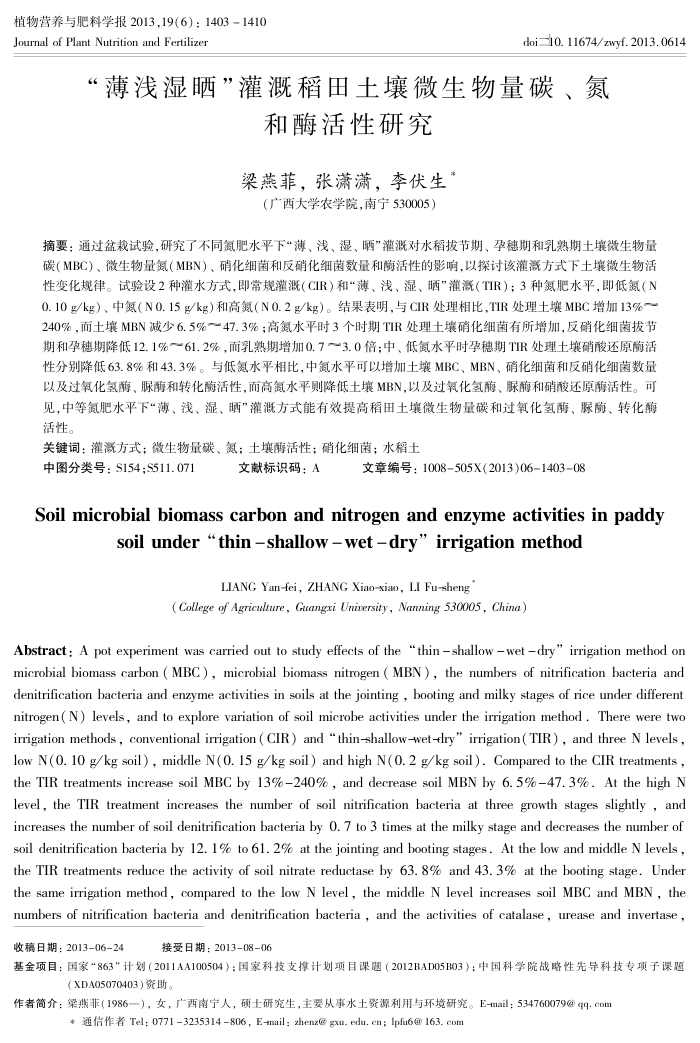“薄浅湿晒”灌溉稻田土壤微生物量碳、氮和酶活性研究
内容简介
 植物营养与肥料学报201319(6):1403-1410 Journal of Plant Nutrition and Fertilizer
植物营养与肥料学报201319(6):1403-1410 Journal of Plant Nutrition and Fertilizerdoi=10.11674/zwyf.2013.0614
“薄浅湿晒”灌溉稻田土壤微生物量碳、氮
和酶活性研究梁蒸菲,张潇满,李伏生*(广西大学农学院,南宁530005)
碳(MBC)、微生物量氮(MBN)、硝化细菌和反硝化细菌数量和酶活性的影响,以探讨该灌溉方式下土壤微生物活性变化规律。试验设2种灌水方式,即常规灌溉(CIR)和“薄、浅、湿、晒"灌溉(TIR);3种氮肥水平,即低氮(N 0.10g/kg)、中氮(N0.15g/kg)和高氮(N0.2g/kg)。结果表明,与CIR处理相比,TIR处理土壤MBC增加13%~ 240%,而土壤MBN减少6.5%~47.3%:高氨水平时3个时期TIR处理土壤硝化细菌有所增加,反硝化细菌拨节期和孕穗期降低12.1%~61.2%,而乳熟期增加0.7~3.0倍;中、低氮水平时孕穗期TIR处理土壤硝酸还原酶活性分别降低63.8%和43.3%。与低氮水平相比,中氮水平可以增加土壤MBC、MBN、硝化细菌和反硝化细菌数量以及过氧化氢酶、脲酶和转化酶活性,而高氮水平则降低土壤MBN,以及过氧化氢酶、脲酶和硝酸还原酶活性。可见,中等氮肥水平下“薄、浅、湿、晒”灌溉方式能有效提高稽田土壤微生物量碳和过氧化氢酶、脲酶、转化酶活性。
关键词:灌溉方式;微生物量碳、氮;土壤酶活性;硝化细菌;水稻土
中图分类号:S154;S511.071
文献标识码:A
文章编号:1008505X(2013)06140308
Soilmicrobial biomass carbonand nitrogen and enzymeactivitiesinpaddy
LIANG Yan-fei, ZHANG Xiao-xiao, LI Fu-sheng
(College of Agriculture, Guangxi Uninersity, Nanning 530005, China)
Abstract: A pot experiment was carried out to study effects of the "thin -shallow -wet dry" irrigation method or microbial biomass carbon (MBC), microbial biomass nitrogen (MBN), the numbers of nitrification bacteria and denitrification bacteria and enzyme activities in soils at the jointing , booting and milky stages of rice under different nitrogen(N) levels, and to explore variation of soil microbe activities under the irrigation method . There were two irrigation methods , conventional irrigation ( CIR) and “ thin-shallow-wet-dry" irrigation(TIR), and three N levels , low N(0. 10 g/kg soil) , middle N(0. 15 g/kg soil) and high N(0. 2 g/kg soil). Compared to the CIR treatments , the TIR treatments increase soil MBC by 13%240% , and decrease soil MBN by 6. 5%-47.3%. At the high N level, the TIR treatment increases the number of soil nitrification bacteria at three growth stages slightly , and increases the number of soil denitrification bacteria by O. 7 to 3 times at the milky stage and decreases the number of soil denitrification bacteria by 12. 1% to 61. 2% at the jointing and booting stages . At the low and middle N levels , the TIR treatments reduce the activity of soil nitrate reductase by 63. 8% and 43. 3% at the booting stage. Under the same irrigation method, compared to the low N level, the middle N level increases soil MBC and MBN, the numbers of nitrification bacteria and denitrification bacteria , and the activities of catalase, urease and invertase,
收稿日期:2013-06-24
接受日期:2013-08-06
基金项目:国家“863"计划(2011AA100504);国家科技支撑计划项目课题(2012BAD05B03);中国科学院战略性先导科技专项子课题
(XDA05070403)资助。
作者简介:梁燕菲(1986—),女,广西南宁人,硕士研究生,主要从事水土资源利用与环境研究。E-mail;534760079@qq.com
*通信作者 Tel: 07713235314806,E-mail; zhenz@ gxu. edu, cn; Ipfu6@163. com